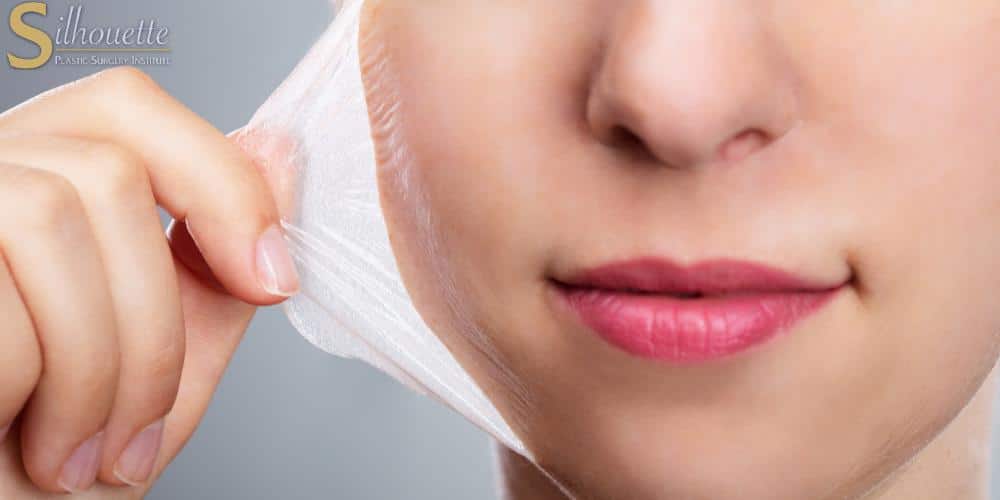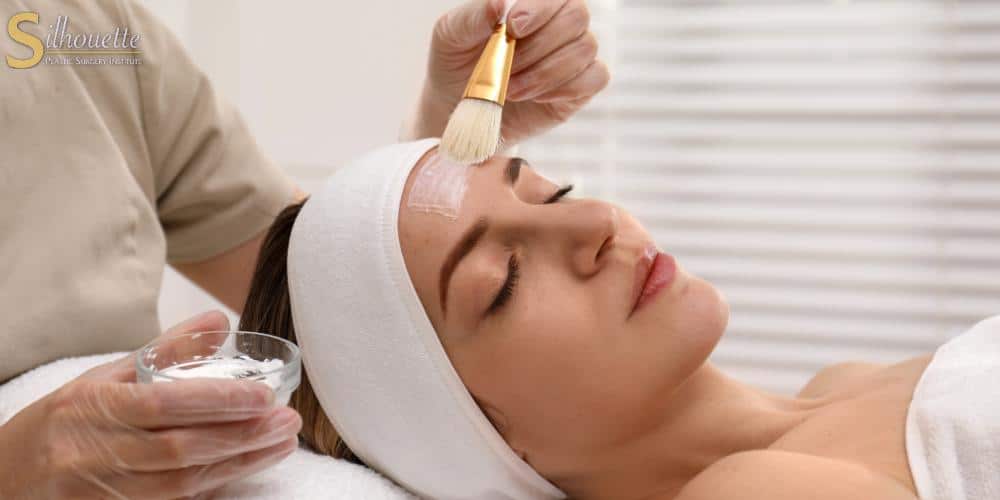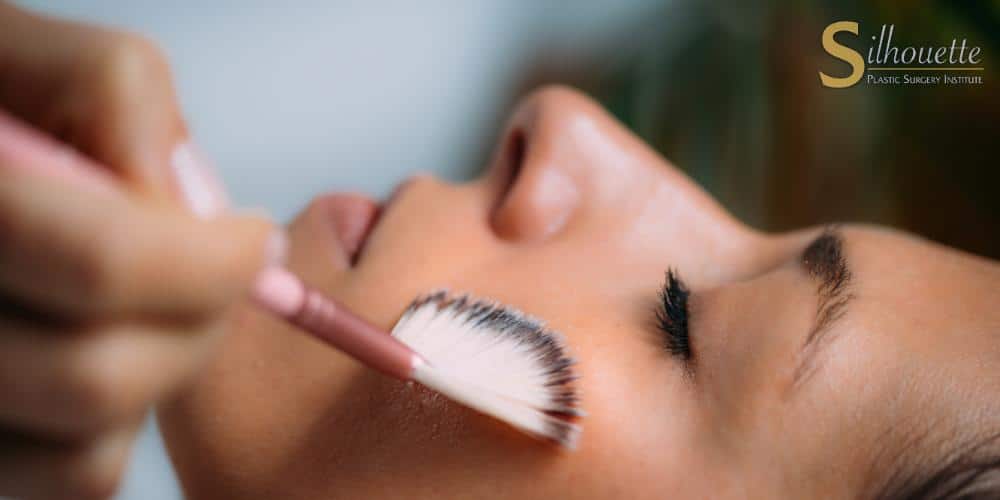Dr. Hootan Daneshmand
Med Spa California
Chemical Peel in Bakersfield, CA
Are you self-conscious about an uneven skin tone, wrinkles, and fine lines? Do you wish you could turn the clock back a few years? If so, a chemical peel may be an option for you. This minimally-invasive procedure can help maximize your skin’s natural, youthful glow.
Chemical peels are a safe and effective way to remove damaged skin cells and encourage the growth of new, healthy skin. This non-surgical procedure can be used on the face, neck, and hands. Chemicals applied to the skin will exfoliate the area and eventually peel off, revealing fresh, rejuvenated skin.
If you’re ready to see a brighter complexion with fewer fine lines and wrinkles, call the Silhouette Plastic Surgery Institute today at 949-359-8397 to schedule an appointment with Dr. Daneshmand.

What is a Chemical Peel?
A chemical peel is exactly what it sounds like–a chemical solution is applied to the skin. The solution exfoliates the skin and later peels off. With nearly 1 million chemical peels performed in 2020, this procedure is the fourth most common minimally-invasive cosmetic procedure.
Chemical peels are convenient and exceptionally safe when applied by a licensed specialist. These treatments can be applied to the hands, neck, upper chest, and face. Chemical peels can treat a variety of skin conditions and ailments. Depending on the type of chemical peel you get, the treatment can even reverse sun damage and scars.
Types of Chemical Peels
At Silhouette Plastic Surgery Institute, we offer three different types of chemical peels. These treatments are classified by how much skin is exfoliated. Dr. Daneshmand will work with you to determine the best chemical peel depending on your goals and expectations. Read on below to learn more about the different types of chemical peels.
A light chemical peel is often called a lunchtime peel. This is because the procedure often takes around 30 minutes to complete and requires the least amount of downtime. These superficial peels use a mild acid to gently exfoliate the epidermis, or the outermost layer of skin.
Medium peels use stronger acids to exfoliate the middle and outer layers of the skin. This makes it easier to remove damaged skin cells.
Deep chemical peels are used to fully remove damaged skin cells. A deep peel penetrates the dermis, or middle layer of skin. These peels often have the most drastic results and often require the most downtime.

How Do Chemical Peels Work?
Chemical peels work by damaging your skin. This sounds backwards, doesn’t it? Think about a peeling sunburn. The sun burns the top layer of the skin and damages the skin cells there. The skin underneath is usually much smoother and softer than the layer that peeled off. Chemical peels work in a similar way. Instead of damaging the skin with harmful UV rays, the top layer of your skin is gently exfoliated with an acid.
The most commonly used acids are salicylic acid, glycolic acid, and trichloroacetic acid. These may sound like scary, harsh chemical names, but they can also be found in normal face washes. At-home exfoliants commonly use alpha-hydroxy acids, which includes glycolic acid. Anyone who has acne or acne scars will likely be familiar with salicylic acid; it’s a common ingredient in acne treatments.
What Can a Chemical Peel Treat?
Chemical peels can safely and effectively treat a variety of skin conditions. At Silhouette Plastic Surgery Institute, we use chemical peels to treat:
- Uneven skin tone
- Dull complexion
- Rough skin
- Some types of acne
- Acne scars
- Sun damaged skin
- Fine lines and wrinkles
- Melasma, or dark patches of skin
- Scarring

What to Expect During a Chemical Peel
Chemical peels are minimally-invasive procedures, so they can be performed as outpatient procedures. Before your appointment, you may have to follow some general instructions in preparation for the chemical face peel. This usually includes:
- Avoiding products containing retinoids for a few weeks before the procedure
- Avoiding direct sun exposure and tanning for a few weeks before the procedure
- Taking any prescribed antibiotics or antiviral medication at least 24 hours before the procedure
- Making sure your skin is free of any infections, open wounds, or lesions.
Dr. Daneshmand will provide specific instructions to follow before your appointment at Silhouette Plastic Surgery Institute.
Immediately before the chemical peel, your face will be prepped and cleaned. Your eyes and hair will be protected from the chemicals. You may receive local or general anesthetic if you’re getting a deep peel. During the procedure, a chemical solution will be applied to your skin. The length of time that the chemical stays on your skin depends on the type of peel and the type of acid used. You may feel a warm or burning sensation for a few moments, but the discomfort will be relieved with a cool compress. The solution will then be washed away or neutralized. After a short time, you’ll be able to go home and await the results.
What to Expect After a Chemical Peel
After a chemical peel, you can expect to get specific instructions from your doctor. You may be advised to avoid sun exposure and avoid getting your skin wet for a few hours, depending on the type of peel you get. Below, we outline what to expect in more detail for each type of peel.
Light peels require little to no downtime. After the peel, you can expect a sunburn-like reaction. Your skin may feel a little sensitive and red, but it should go away in three to five days. You can usually wear makeup the next day, but follow your doctor’s instructions. It may take three to five peels to get your desired results. Light peels can be repeated every two to five weeks, depending on the condition of your skin.
Medium peels require a longer recovery period. You can expect increased redness, swelling, and blisters. Your skin will be healed in one to two weeks. Your doctor may recommend daily soaks or a specialized ointment. It’s important to keep your skin hydrated during this period. You may need to continue antiviral medication. Avoid makeup for about a week. Medium peels can be repeated after six months to a year to maintain results if needed.
Deep chemical peels require the most extensive recovery period. After a deep peel, your skin will be incredibly sensitive. The recovery period for a deep peel is two to three weeks. Your skin will likely be bandaged for the first few days. It’s common for the eyes to swell shut after a deep peel. Your doctor will instruct you to perform daily soaks followed by ointment. You will be advised to avoid sun exposure for a few months.
Deep peels can only be performed on the face once.
It’s important to remember that your new skin is incredibly fragile after a chemical peel. Remember to follow your doctor’s advice closely to prevent complications and unwanted results.
Chemical Face Peel Side Effects and Risks
As with any medical procedure, there are possible risks and side effects. Chemical peels are minimally-invasive procedures and safe if performed by a licensed practitioner. Some people may have a higher risk of possible side effects than others. Some of the more common side effects include:
- Skin irritations
- Flare-ups of cold sores
- Permanent change in skin color
- Loss of the ability to tan
- Scarring
- Fungal or bacterial infections
How Long Does It Take to See Results From a Chemical Peel?
Light peels often need up to five procedures before the desired results are achieved. The skin recovers quickly from this procedure, often in as little as one to seven days. The results from this superficial peel are often subtle.
Medium peels can take up to two weeks to heal and show results. A medium peel can give your skin a fresh glow.
Deep peels can take 21 days to heal, but redness can persist for months. The results from a deep peel are the most dramatic.
How Long Do Chemical Peel Results Last?
Depending on the type of chemical peel and the desired aesthetic, the results can vary. Deep peels often have permanent results. Light peels can be repeated several times until you achieve the desired results. Medium peels can be repeated every six months to a year to maintain results.
How Much Does a Chemical Peel Cost?
The average cost of a chemical peel is $519, but this cost can vary depending on different factors. Light peels can cost as little as $100, but many people get three to five light peels for their desired results. Deep peels can cost anywhere from $2,000 to $6,000. Deep peels require a significantly longer recovery time, but the results are permanent.
Can I Combine a Chemical Peel With Other Skin Procedures?
Some issues cannot be treated with chemical peels. Deep scars, extensive wrinkling, and sagging skin usually don’t respond to chemical face peels.
At Silhouette Plastic Surgery Institute, Dr. Daneshmand offers a variety of cosmetic treatments and procedures. While some procedures cannot be combined with others, sometimes it just makes sense to combine procedures to reduce the recovery period. Dr. Daneshmand can develop a unique, personalized treatment plan just for you. Some of the other skin treatments and procedures we offer include:

